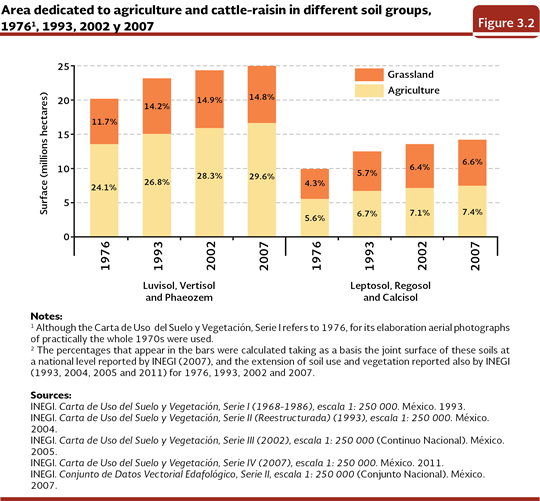
| CHAPTER 3. SOILS |
In Mexico there are many kind of soils that can be explained by the interaction of several factors, within those factors there is the complex topography started by the Cenozoic volcanic activity, the wide altitudinal gradient (that goes from zero to more than 5,600 meters above the sea level), the presence of the great four of five types of climates acknowledged by the Köppen1 classification and the rich variety of landscapes and types of rocks that are in the territory (see Box: What is soil and how is it formed?). SOILS OF MEXICO According to INEGI (2007), there are in Mexico 26 of the 32 groups of soil acknowledged by the International Union of Soil Sciences (IUSS, 2007). The dominant types are Leptosols (28.3% of the territory), Regosols (13.7%), Phaeozems (11.7%), Calcisols (10.4%), Luvisols (9%) and Vertisols (8.6%) that, as a whole, take 81.7% of the national surface (Figure 3.1).
In the 52.4% of the national territory there are superficial and little-developed soils: Leptosol (54.3 million hectares), Regosols (26.3 millions) and Calcisols (20 millions), which make difficult their agricultural exploitation and increase their erosion vulnerability. Soils with most fertility: Phaeozems, Luvisols and Vertisols (22.5, 17.3 and 16.5 million hectares, respectively) as a whole, cover 29.3% of the country (Figure 3.1; Map 3.1). In the rest of the territory (about of 35 million hectares) the other 20 edaphic groups are present, which are distributed in a big amount of relief, microclimate and vegetation types (Table D3_SUELO01_01). For more information about soil characteristics of the soils in the country go to the Box Mayor soil groups in Mexico.
Agriculture and groups of soils Over the last decades, the intensity in the agricultural development of the country determined that the richest and deepest soils, with a great structure and high levels of nutrients and organic matter had more demand. Between the middle of the 1970s and by the end of the first decade of the 21st century, the percentage of Luvisols, Vertisols and Phaeozems devoted to agricultural activities went from 35.8% (24.1% devoted to agriculture and 11.7% to grassland for livestock) to 44.4% (29.6% in agriculture and 14.8% to grassland). To a lesser extent, soils which are considered as less suitable for agriculture or livestock (just as Leptosols, Regosols and Calcisols) have also been used with these purposes. By the middle of the 1970s, 9.9% of the national surface of this set of soils was devoted to agricultural activities, while at the end of the first decade of the 21st century, this figure rose to 14% (7.4% in agriculture and 6.6% in grassland; Figure 3.2).
Note: 1 According to Garcia´s modification (1988).
|


